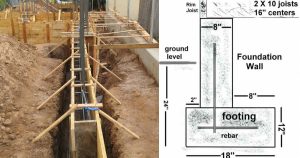You must adhere to building regulations if you are required to support all or part the foundations for your building. Building regulations apply to this type of work, which is specifically defined as “building works”. Adequate measures must then be taken to make sure the foundations stabilize the building.
You will also need to take care to avoid any drains or sewers that may be nearby, continue reading?

It is a construction method that increases the depths of foundations for a building. Excavation is done to remove the soil underneath an existing foundation. The foundation material is then replaced in stages, usually concrete.
Design, method and safety are important considerations when it comes to underpinning. The risks of this type of work are very real and can lead to damage or collapse of an existing house if it is not performed properly.
These reasons are:
This is due to soil problems or soil condition changes.
It has been decided to build another floor, whether above ground or below, and that the existing foundations will not support this modified structure or its weight.
It is important to plan and execute the work very carefully. The building regulations usually require that you get approval before underpinning an already existing foundation. To obtain such an approval, you’ll need to create a structure design for your underpinnings. You will also have to describe the procedure that is going be followed during the construction. The first step before any substantial construction is to dig a small hole next to the footings. An engineer will then assess how the project can proceed.
Methods for inspection
The method of underpinning to use will depend on many factors. Excavations for underpinning must follow engineer instructions in order to avoid further damaging structures above.
You should be aware that if the work isn’t done properly it can lead to damage and collapse of your home. For this project it is best to hire professionals with expertise in the areas of design (for instance a designer or structural engineer who has experience) and construction.
Typical method involves completing short sections at a given time. The amount of underpinning that is required may allow for multiple sections to be done simultaneously, as long as they are far enough apart.
A design engineer, as well as a building surveyor will usually inspect the excavation before concrete is poured. It is possible that there will still be gaps between the concrete and existing foundation. Filling in the excavations with concrete does not guarantee that it will support the foundation. To ensure support it is necessary to fill the space with a mix of cement and sand. Engineers and surveyors can inspect the void.
The structural engineer will design the appropriate timing for each stage, as well as the specifications of materials that should be used.